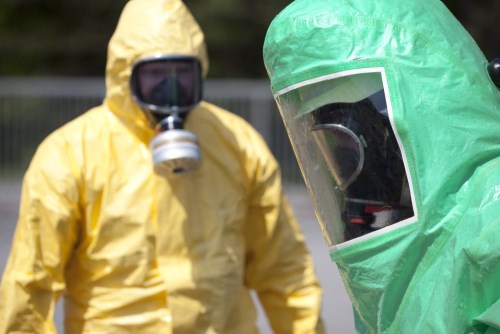Hazardous Materials Incidents
Learn about Hazardous Materials

Hazardous materials can be: flammable or combustible, explosive, toxic, reactive, corrosive, or radioactive.
Hazardous material releases are most often due to transportation accidents or accidents at facilities. Large-scale hazardous materials incidents are less common than other types of disasters but can be dangerous and even deadly.
The most important action you can take is to remove yourself from the affected area.
Before a Hazardous Materials Incident
Protect yourself from a hazardous materials incident before they occur:
- Build an Emergency Supply Kit with the addition of plastic sheeting, duct tape, and scissors.
- Make a Family Emergency Plan, and remember to include emergency planning for your pets.
- Know how to operate your home’s ventilation system.
- Identify an above-ground shelter room with as few openings as possible.
- Read more about sheltering in place.
During a Hazardous Materials Incident
- Listen to local radio or television stations for detailed information and follow instructions carefully.
- Keep in mind that some toxic chemicals are odorless.
| If you are instructed to evacuate: |
In some situations, you could be directed to evacuate. Make sure to:
|
| If you are instructed to shelter in place: |
In some situations, you could be directed to shelter in place. Make sure to:
|
| If you are caught outside or in your car: |
|
After a Hazardous Materials Incident
- Listen to local radio or television stations for the latest emergency information.
- Act quickly if you have come in to contact with or have been exposed to hazardous chemicals.
- Follow decontamination instructions from local authorities.
- Seek medical treatment for unusual symptoms as soon as possible.
- Place exposed clothing and shoes in tightly sealed containers.
- Advise everyone who comes in to contact with you that you may have been exposed to a toxic substance.
- Return home only when authorities say it is safe.
- Open windows and vents and turn on fans to provide ventilation.
- Find out from local authorities how to clean up your land and property.
- Report any lingering vapors or other hazards to your local emergency services office.
Contact Us
The County Office of Emergency Services (OES)
1055 Monterey Street D430
San Luis Obispo, CA 93408
County OES Business Line: 805-781-5678
County OES Business Email: oes@co.slo.ca.us




